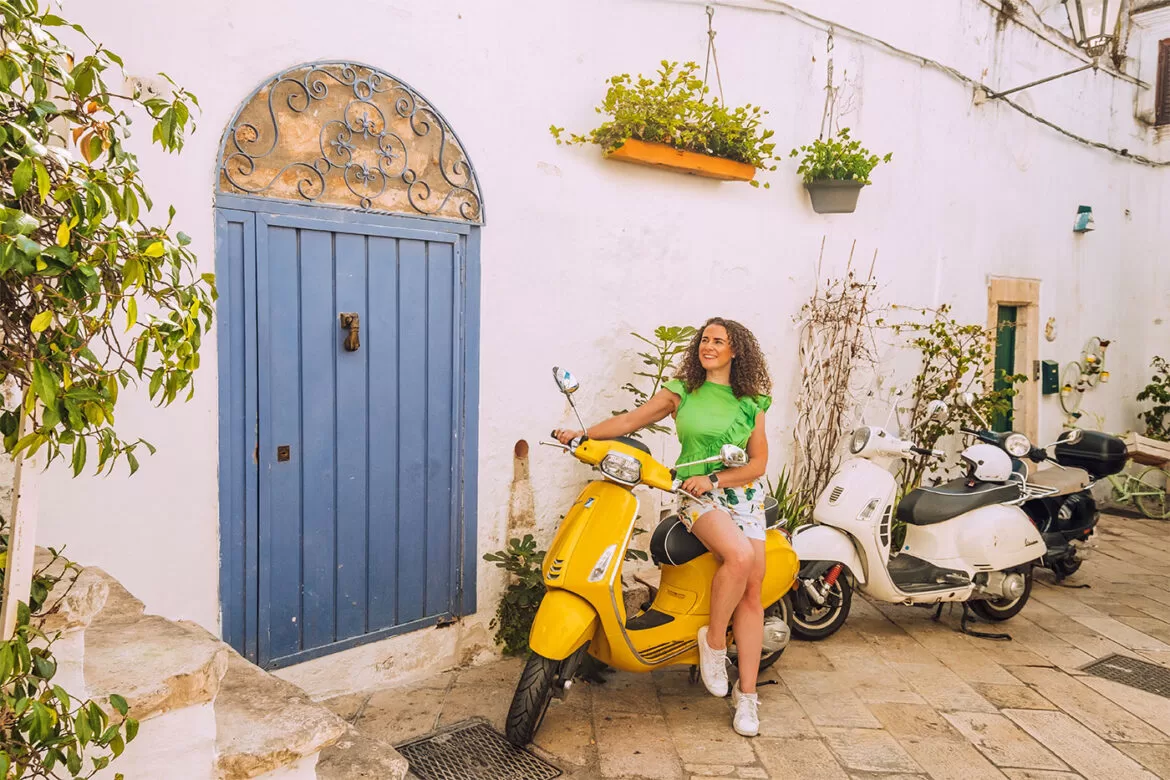If you’re travelling to Italy or learning Italian, chances are you’re eager to connect with friendly locals. This can happen in various situations, from a serendipitous encounter during a day trip to Pisa, to a meeting your Italian colleagues in the Rome office. What better way to break the ice than by introducing yourself in Italian? Now, don’t go thinking you need to be the next Dante, spinning sonnets left and right – introducing yourself in Italian is much simpler than you think!
In this guide, I break down the basics of how to introduce yourself in Italian – so you can say your name, talk about where you’re from, and more – along with some handy tips and examples for various situations, so you can make a bella figura (good impression).
So, pour yourself a drink and prepare to master introductions that will have Italians exclaim Che bravo/a! (How impressive!) in no time! But first, make sure to download your free PDF cheat-sheet, which includes all the key points we’ll cover in this guide. Just enter your email below and I’ll send it to you straight away.
Table to Contents
Here’s what we’ll cover in this guide. Click on any title to jump to each section.
- Formal vs Informal introductions in Italian
- Basic phrases to introduce yourself in Italian
- How to Make Small Talk in Italian
- Let’s practice! Putting it all together
- 5 top tips to remember when introducing yourself in Italian
Formal vs Informal introductions in Italian
When it comes to introducing yourself in Italian, there are two main approaches: formal and informal. I know, it’s the classic dilemma of learning Italian!
Formal introductions are appropriate for situations where you’re meeting someone older or a professional – think doctors, professors, or your nonna’s friends! In these cases, it’s customary to use the formal “Lei” and keep things brief and respectful. For example:
- Sono Maria Rossi, piacere di conoscerLa – I’m Maria Rossi, pleased to meet you
- Buongiorno signora, sono Laura, la nipote di Gina. Piacere di conoscerLa – Good morning ma’am, I’m Laura, Gina’s granddaughter. Nice to meet you.
Informal introductions, on the other hand, are suitable for meeting kids or someone younger in general. They are also quite common in casual work environments like startups. In these instances, skip the formalities and go for a friendly Ciao! (Hello!) and a relaxed tone. For example:
- Ciao, sono Maria. Piacere! – Hello, I’m Maria. Nice to meet you!
- Ciao, mi chiamo Paolo. Piacere di conoscerti! – Hello, my name is Paolo. Nice to meet you!
Feeling unsure? Don’t worry! Italians understand that navigating formal and informal addresses can be tricky for foreigners. Remember, you can always double-check if it’s appropriate to use informal language by asking, Possiamo darci del tu? (Can we use informal language with each other?).
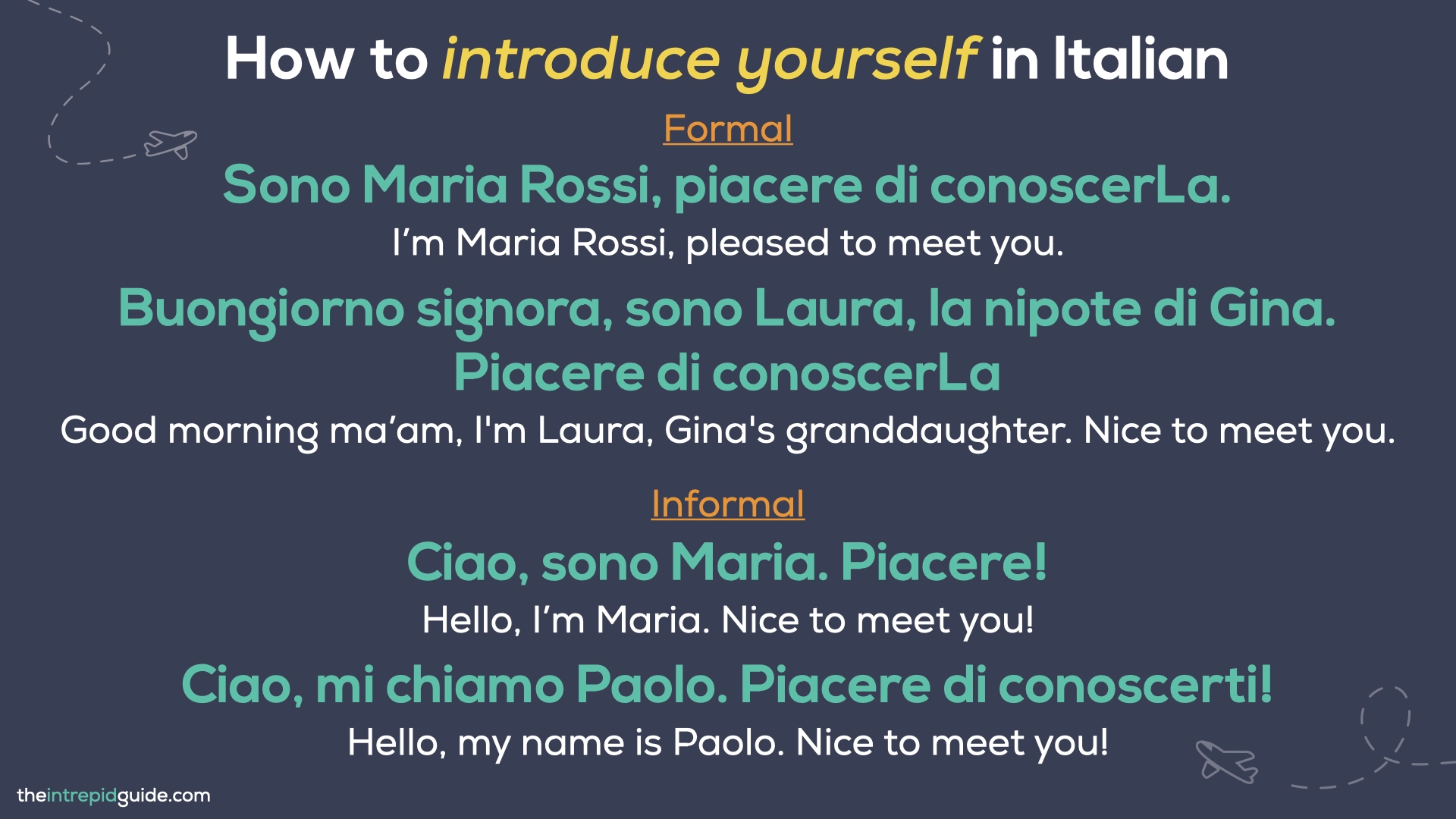
Basic phrases to introduce yourself in Italian
Introducing yourself in Italian is all about getting the essentials just right – greeting with flair, confidently sharing your name, and, if you are not alone, gracefully introducing others. Let’s break down these components step by step.
Step 1: How to say hello in Italian
When being introduced to somebody or upon meeting somebody for the first time, a warm smile accompanied by a cheerful Ciao! (Hello!) or a pleasant Buongiorno! (Good morning) can truly set a positive tone for the conversation.
These Italian greetings are fundamental in your language journey, serving as key elements of everyday talk. Depending on the time of day and how formal the situation is, here’s what you can use:
| Italian greetings | ||
|---|---|---|
| Italian | English | Situation |
| Ciao | Hello/Hi | Informal |
| Salve | Hi | Formal |
| Buongiorno | Good morning | Formal |
| Buon pomeriggio | Good afternoon | Formal |
| Buonasera | Good evening | Formal |
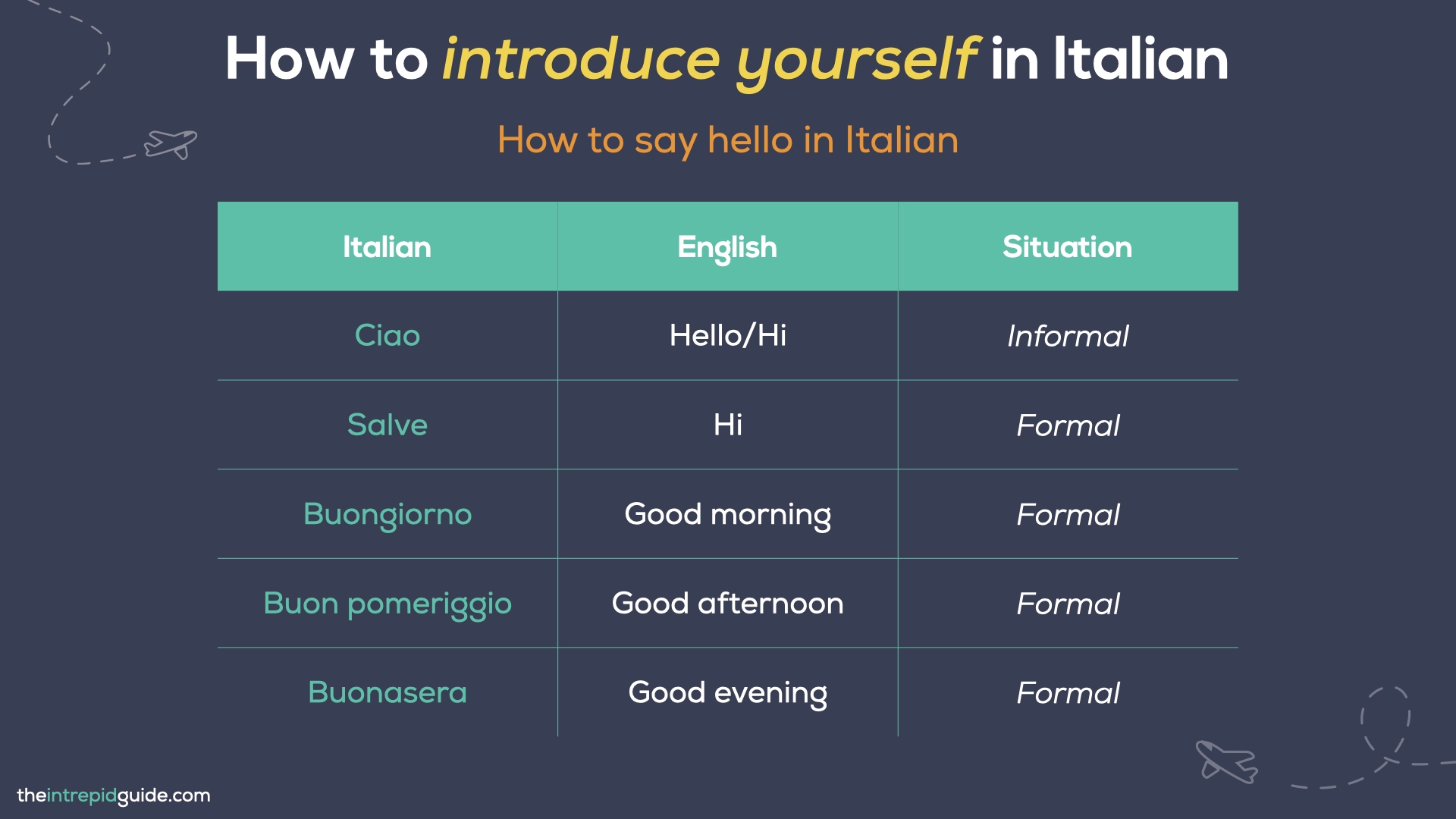
To learn more Italian greetings, watch this video lesson.
Step 2: How to ask “What is your name?” in Italian
Once the greetings are over, it’s time to introduce yourself by your name. You can do this using either the verb essere (to be) or chiamarsi (to be called):
| Saying your name in Italian | |
|---|---|
| Italian | English |
| Mi chiamo [nome] | I am called [name] |
| Il mio nome è [nome] | My name is [name] |
| Sono [nome] | I am [name] |
Typically, if you share your name first, it’s natural to ask for the other person’s name in return. How you do this can depend on how formal or casual the situation is. Here are some common ways to do it:
| Asking the name in Italian | ||
|---|---|---|
| Italian | English | Situation |
| Mi chiamo [nome] e tu? | I am called [name] and you? | Informal |
| Sono [nome] e tu? | I am [name] and you? | Informal |
| Come ti chiami? / Tu come ti chiami? | What is your name? | Informal |
| Come si chiama? / Lei come si chiama? | What is your name? | Formal |
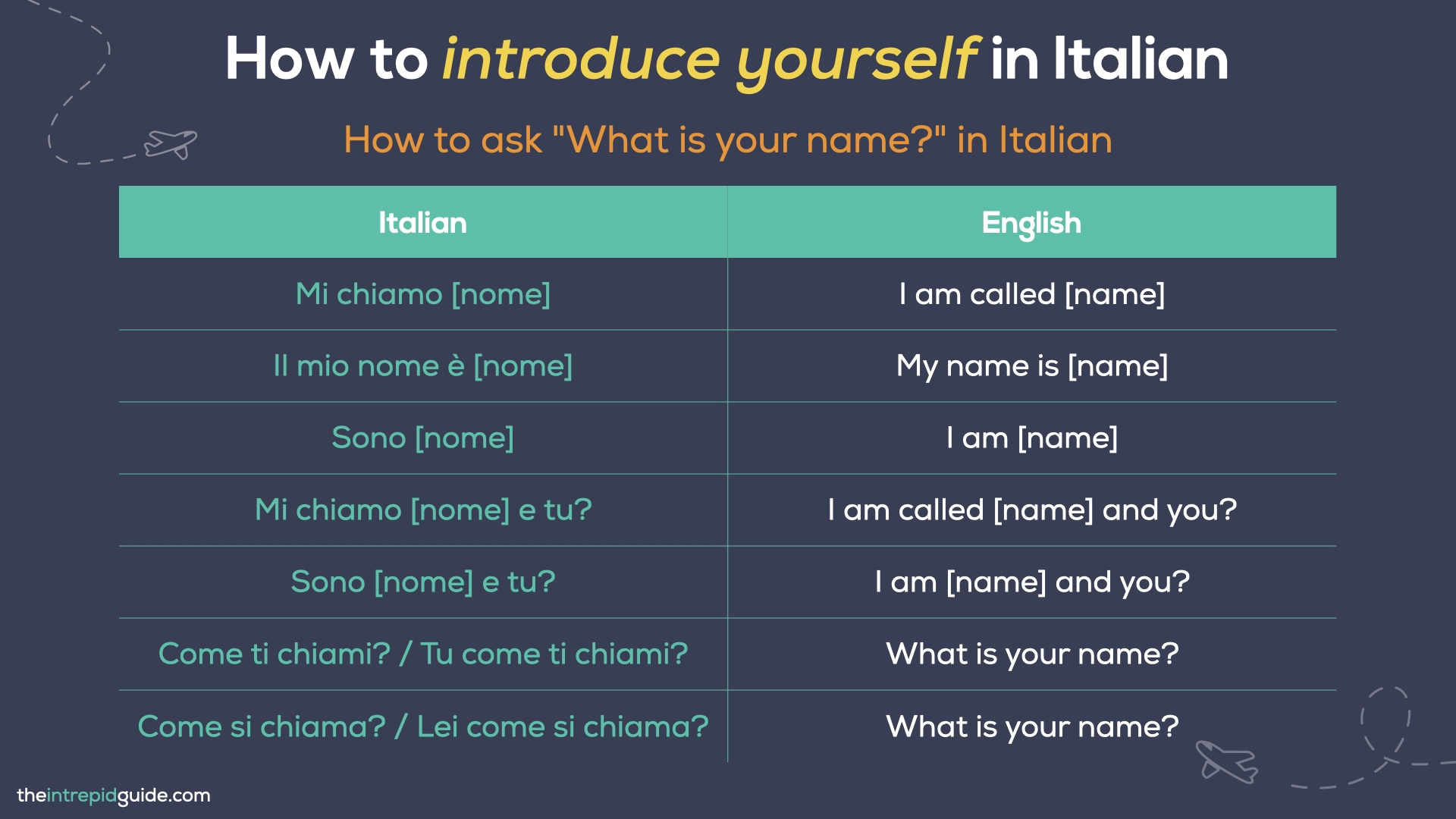
Step 3: How to say “It’s nice to meet you” in Italian
Now that you’ve exchanged names, it’s nice to express how delightful it is to have made each other’s acquaintance. After all, there’s something magical about meeting someone new! Again, depending on the vibe and setting, there are different ways to to express your delight and respond accordingly.
Note: while English uses the verb “to meet” for such circumstances, in Italian, this sentiment is conveyed through the verb conoscersi (to know), emphasizing the act of knowing rather than simply meeting.
What to say in informal conversations
Piacere – Nice to meet you: simple yet effective, great for any situation. You can add molto (very) at the beginning for a sprinkle of excitement. Examples:
- Ciao, sono Maria. Piacere! – Hello, I’m Maria. Nice to meet you!
- Ciao, mi chiamo Andrea. Molto piacere! – Hello, my name is Andrea. Very nice to meet you!
Piacere di conoscerti – Pleasure to meet you: though not widely used, this informal expression is handy in various scenarios, from chatting at work to meeting a kid. Examples:
- Ciao, sono Luca. Piacere di conoscerti! – Hi, I’m Luca. Pleasure to meet you! [In the office]
- Ciao Claudio, io sono Lucia. Piacere di conoscerti! – Hello Claudio, my name is Lucia. Pleasure to meet you! [Talking to a kid]
How to reply in informal conversations:
- Piacere / Piacere mio – It’s a pleasure / The pleasure is mine: simple and easy, perfect in all informal situations.
What to say in formal conversations:
Piacere di conoscerLa – Pleasure to meet you: polite, respectful, and just the right touch of warmth for formal settings. Examples:
- Salve, sono Anna Bianchi. Piacere di conoscerLa. – Hi, I’m Anna Bianchi. Pleasure to meet you! [Introducing yourself to your new boss]
- Buonasera, sono Paolo. Piacere di conoscerLa. – Good evening, I’m Paolo. Pleasure to meet you. [Meeting your future mother-in-law]
È un vero piacere – It’s a real pleasure:
- Professoressa Rossi, sono Paola Grandi, la mamma di Cesare. È un vero piacere. – Professor Rossi, I’m Paola Grandi, Cesare’s mother. It’s a real pleasure.
- Buonasera a tutti, è un vero piacere conoscervi e presentarvi il nostro nuovo progetto. – Good evening, everyone, it’s a real pleasure to meet you and present our new project.
Molto lieto/a – Very pleased: a classy option for the most formal meetings. It varies based on the gender of the speaker. You can also say Lieto/a di conoscerLa (Pleased to meet you) and Molto lieto/a di conoscerLa (Very pleased to meet you). Examples:
- Buonasera, sono Mario Rossi. Molto lieto. – Good evening, I’m Mario Rossi. Very pleased.
- Salve, mi chiamo Anna Bianchi. Lieta di conoscervi. – Hi, my name is Anna Bianchi. Very pleased to meet you.
Felice di fare la sua conoscenza – Delighted to make your acquaintance: this one’s for super formal settings, showing genuine pleasure in meeting someone. Examples:
- Buongiorno Professore. Sono la dottoressa Bianchi, felice di fare la sua conoscenza. – Good morning, Professor. I’m doctor Bianchi, delighted to make your acquaintance.
- Salve Dottor Rossi, sono l’Ingegner Grassi, felice di fare la sua conoscenza. – Hi Doctor Rossi. I’m Engineer Grassi, delighted to make your acquaintance.
How to reply in formal conversations:
- Piacere mio / Il piacere è mio – The pleasure is mine: a polite classic that fits well in formal conversations.
- Altrettanto – Likewise: a slightly less common option, but equally graceful
Here’s a fun fact: according to etiquette, Italians should avoid using Piacere (Pleasure/Nice to meet you) and its variants because you can never be entirely sure if an encounter will genuinely be a pleasure. A classic Ciao (Hello), Salve (Hi), or the ever-polite Buongiorno/Buonasera should be used instead. Sounds logical, right? However, these expressions are so ingrained in everyday Italian that tradition takes precedence over sincerity!
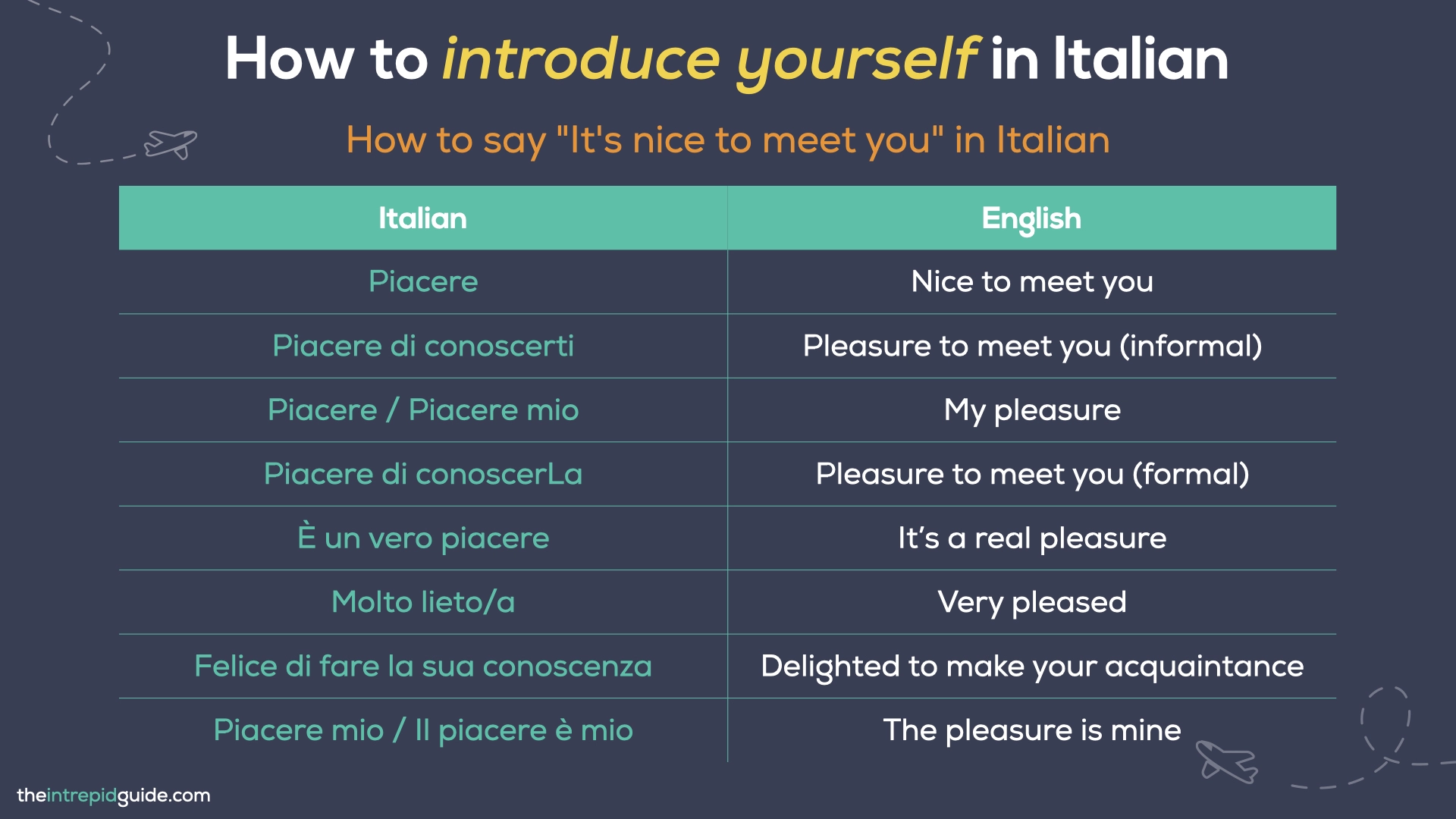
Step 4: How to introduce someone else (friend/partner/relative)
Whether you’re unveiling your new flame to your friends or introducing your partner at a formal occasion, the following table gives you the best expressions to use in all situations:
| Introducing others in Italian | ||
|---|---|---|
| Italian | English | Situation |
| Questo/a è [nome] – Questi/e sono [nomi] | This is [name] – These are [names] | Formal/Informal |
| Lui/Lei è [nome] – Loro sono [nomi] | He/She is [name] – They are [name] | Formal/Informal |
| Ti presento [nome] | Let me introduce you to [name] | Informal |
| Le presento [nome] | Let me introduce you to [name] | Formal |
| Posso presentarti [nome] | May I introduce you to [name] | Informal |
| Posso presentarle [nome] | May I introduce you to [name] | Formal |
| Conosci [nome]? | Have you met [name]? | Informal |
| Conosce [nome]? | Have you met [name]? | Formal |
Remember, adding a touch of personal detail or a descriptive element can make the introduction more engaging. Here are some examples:
- Le presento Anna Bianchi, responsabile marketing dell’azienda, nonché mia moglie – Let me introduce you to Anna, the marketing manager of the company, as well as my wife.
- Questi sono Gianni e Luigi, miei amici di vecchia data – These are Gianni and Luigi, longtime friends of mine.
- Lei è Stefania, mia sorella maggiore che si è trasferita a Londra – She is Stefania, my older sister who moved to London.
- Conosci Andrea, il mio collega che si occupa di PR? – Have you met Andrea, my colleague who handles PR?
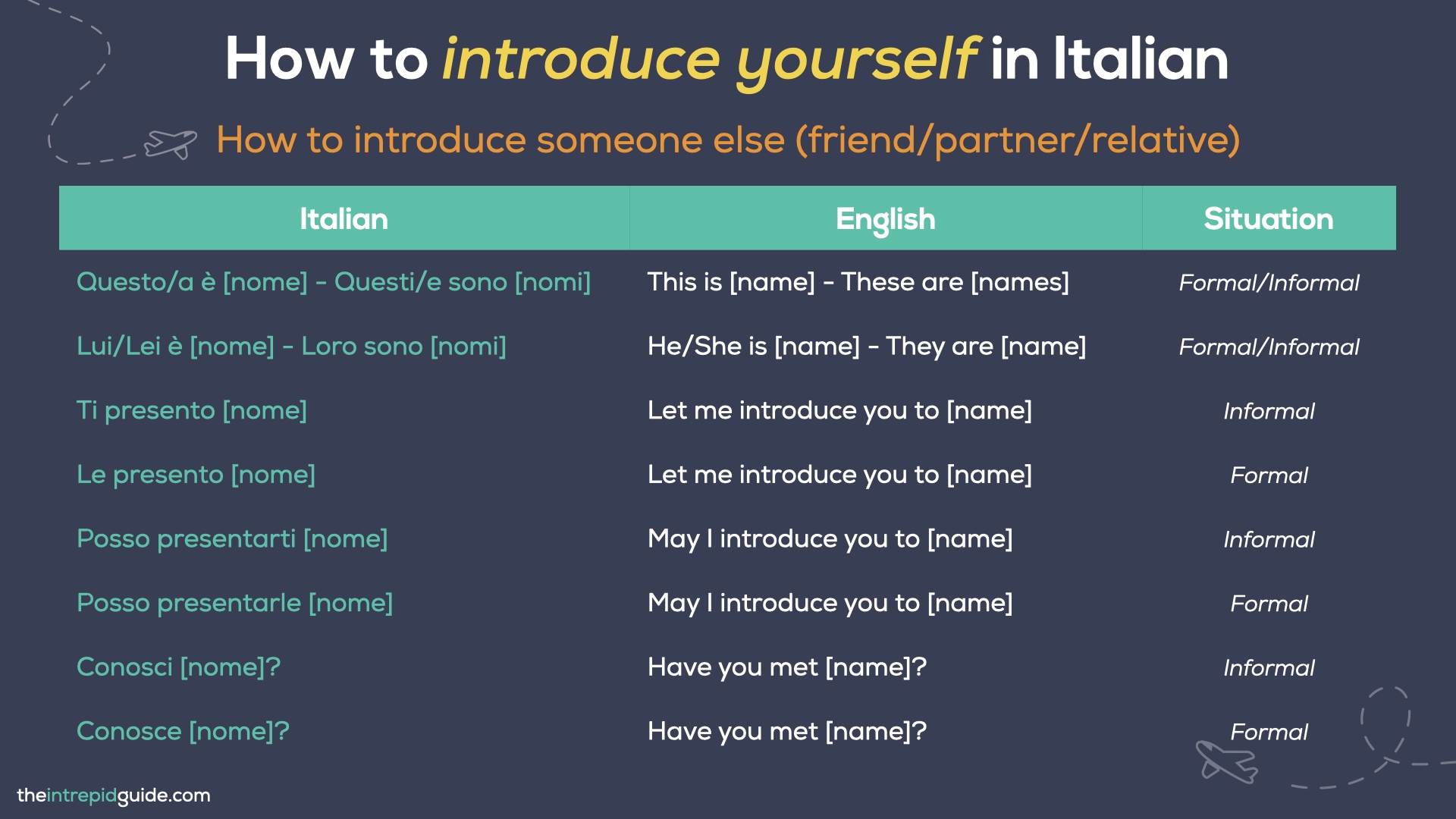
How to Make Small Talk in Italian
When meeting someone new, it is common to engage in basic conversation topics to break the ice and get a feel for each other. Remember, the key is to keep it light, casual, and let the conversation flow naturally. Let’s explore some of the most common small talk topics to kickstart your conversations!
How to say “How are you?” in Italian
Starting with the classic “how are you” in Italian sets the perfect tone for a friendly exchange. Here are some common ways to ask the question and respond:
- Come va? – How’s it going? (Formal/Informal)
- Come stai? – How are you? (Informal)
- Come sta? – How are you? (Formal)
- Bene, grazie. Tu? – Good, thanks. You? (Informal])
- Bene grazie. Lei? – Good, thanks. You? (Formal)
- Non c’è male, tu? – Not bad, you? (Informal)
- Non c’è male, Lei? – Not bad, you? (Formal)
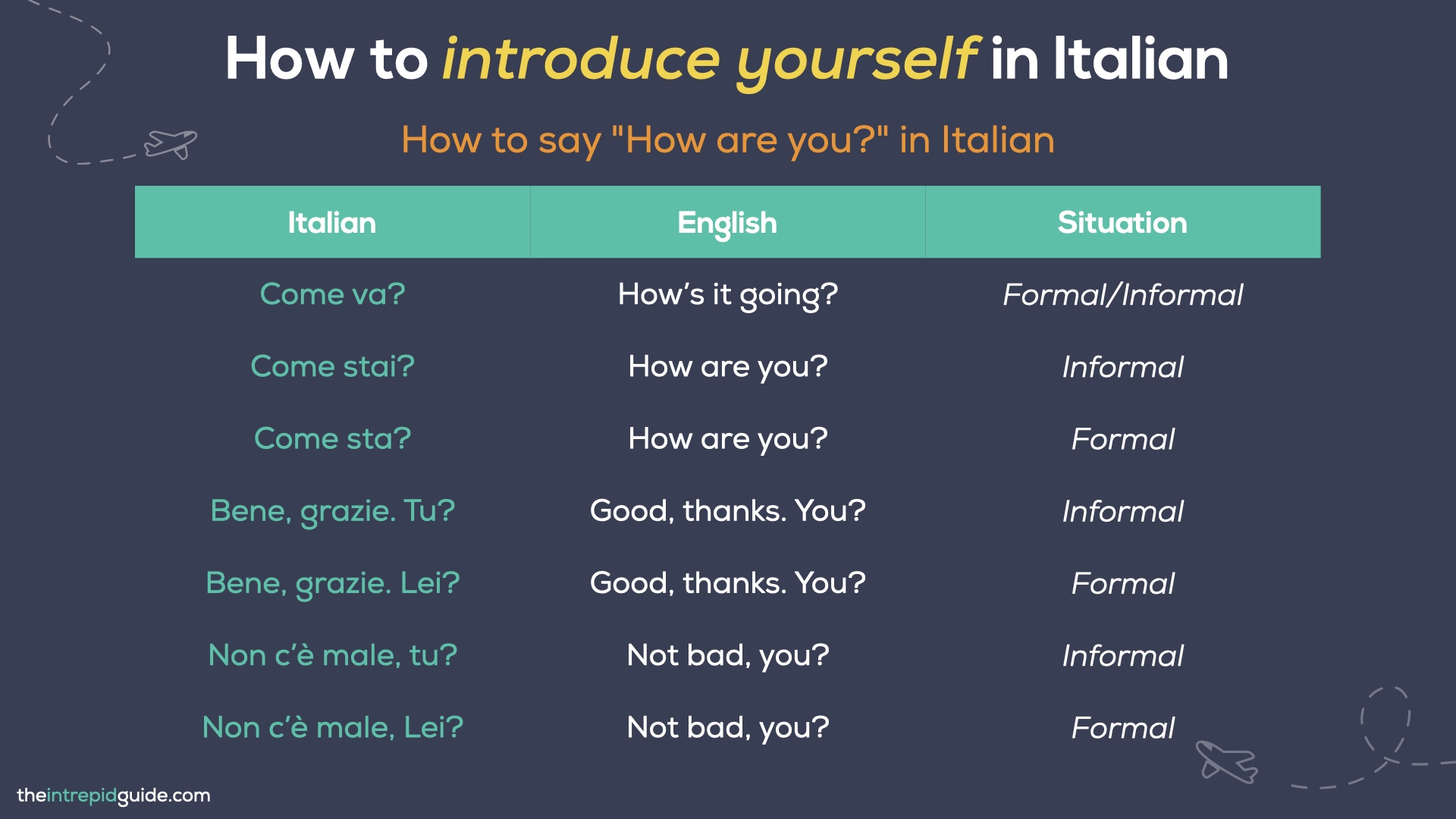
How to say “Where are you from?” in Italian
Inquiring about someone’s place of origin often piques curiosity and keeps the conversation flowing. These simple expressions will help you discuss this topic:
- Di dove sei? – Where are you from? (Informal)
- Di dov’è? – Where are you from? (Formal)
- Da dove vieni? – Where do you come from? (Informal)
- Da dove viene? – Where do you come from? (Formal)
- Sono… [nationality] – I’m… [nationality]
- Sono di… [hometown] – I’m from… [hometown]
- Vengo da/dalla… [hometown/home country] – I come from… [hometown/home country]
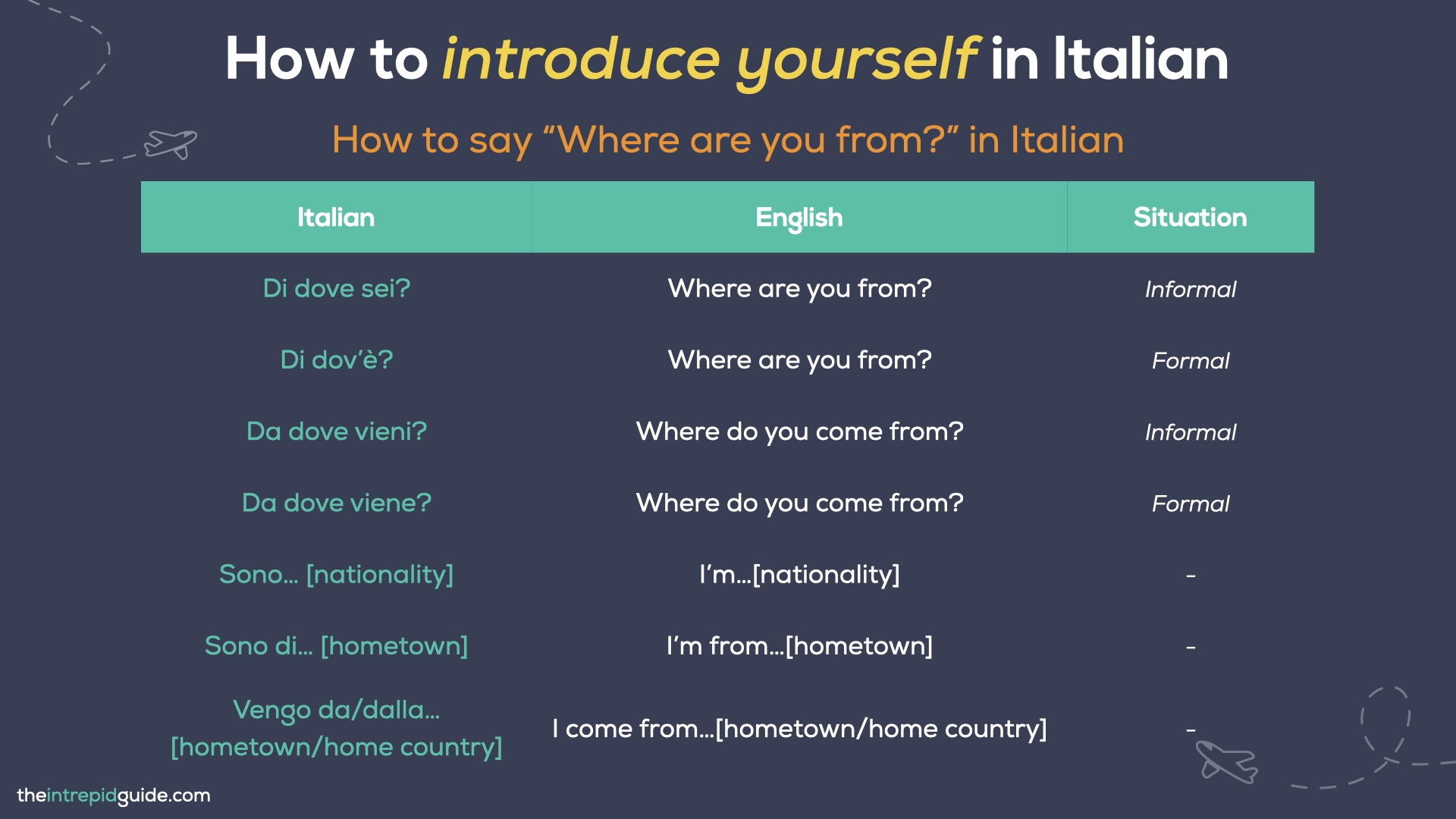
How to say “Where do you live?” in Italian
Similarly, if they’re not originally from their current location, you can delve deeper by asking about their hometown with these questions:
- Dove vivi/Dove abiti? – Where do you live? (Informal)
- Dove vive/Dove abita? – Where do you live (Formal)
Remember, when discussing your place of residence, vivere and abitare are interchangeable, both meaning “to live.”
- Vivo/Abito a… [place] – I live in… [place]
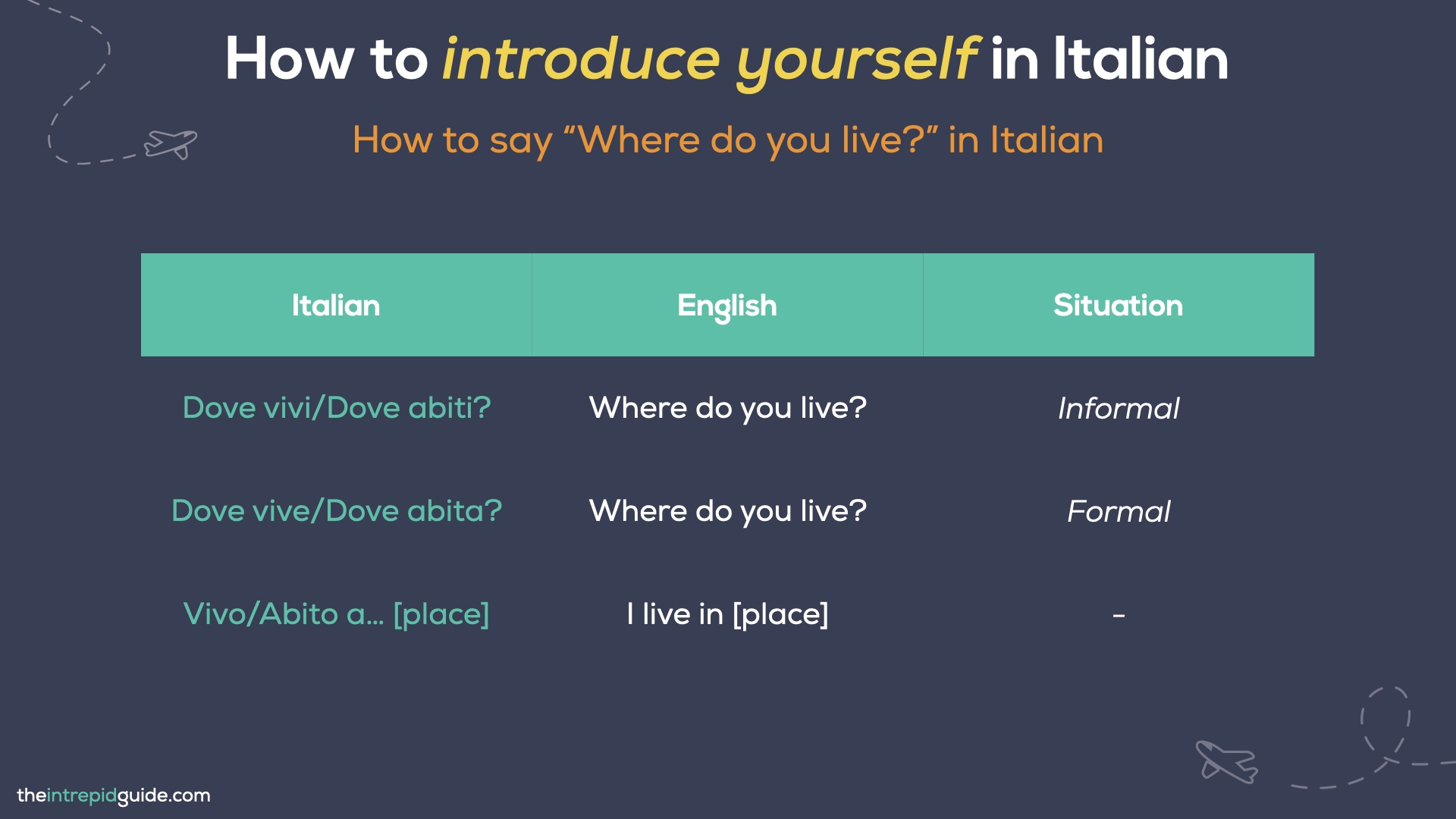
How to say “What do you do?” in Italian
Work-related chatter is another common topic for initial interactions, one often leading to engaging conversations.
- Cosa fai nella vita? – What do you do for a living? (Informal)
- Che lavoro fai? – What is your job? (Informal)
- Di cosa ti occupi? – What do you do for a living? (Informal)
- Di cosa si occupa? – What do you do for a living? (Formal)
- Sono… [job title] – I am… [job title]
- Faccio il/la… [job title] – I am… [job title]
- Lavoro come… [job title] – I work as… [job title]
- Lavoro per… [company name] – I work for… [company name]
- Mi occupo di… [field of work] – I work in… [field of work]
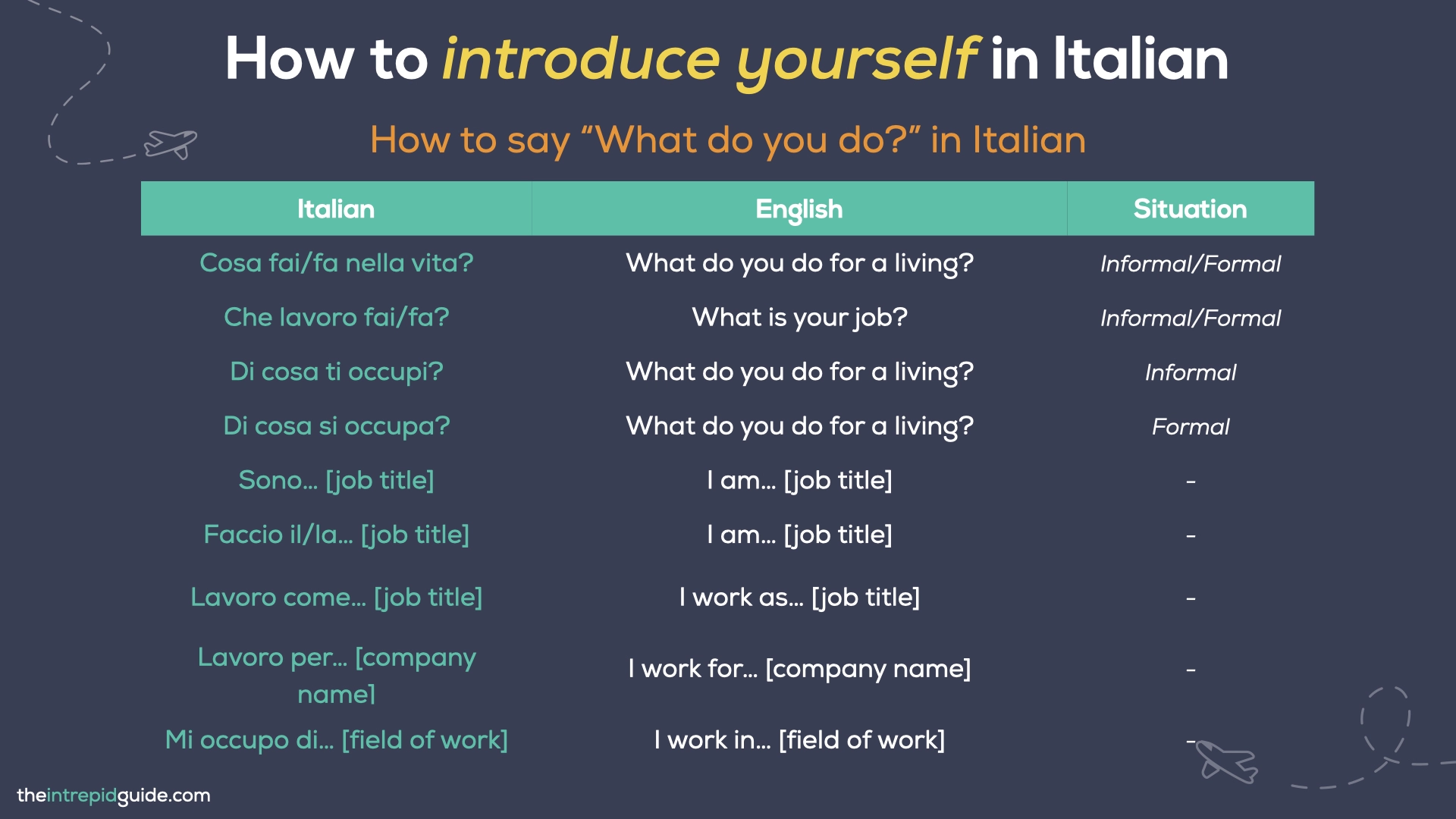
How to say “How old are you?” in Italian
While talking about your age and birthday is not typically a first-time conversation topic, this question may arise, especially among younger individuals or when chatting with children. Therefore, it’s always good to know how to ask and respond.
- Quanti anni hai? – How old are you? (Informal)
- Quanti anni ha? – How old are you? (Formal)
- Ho… anni – I am… years old
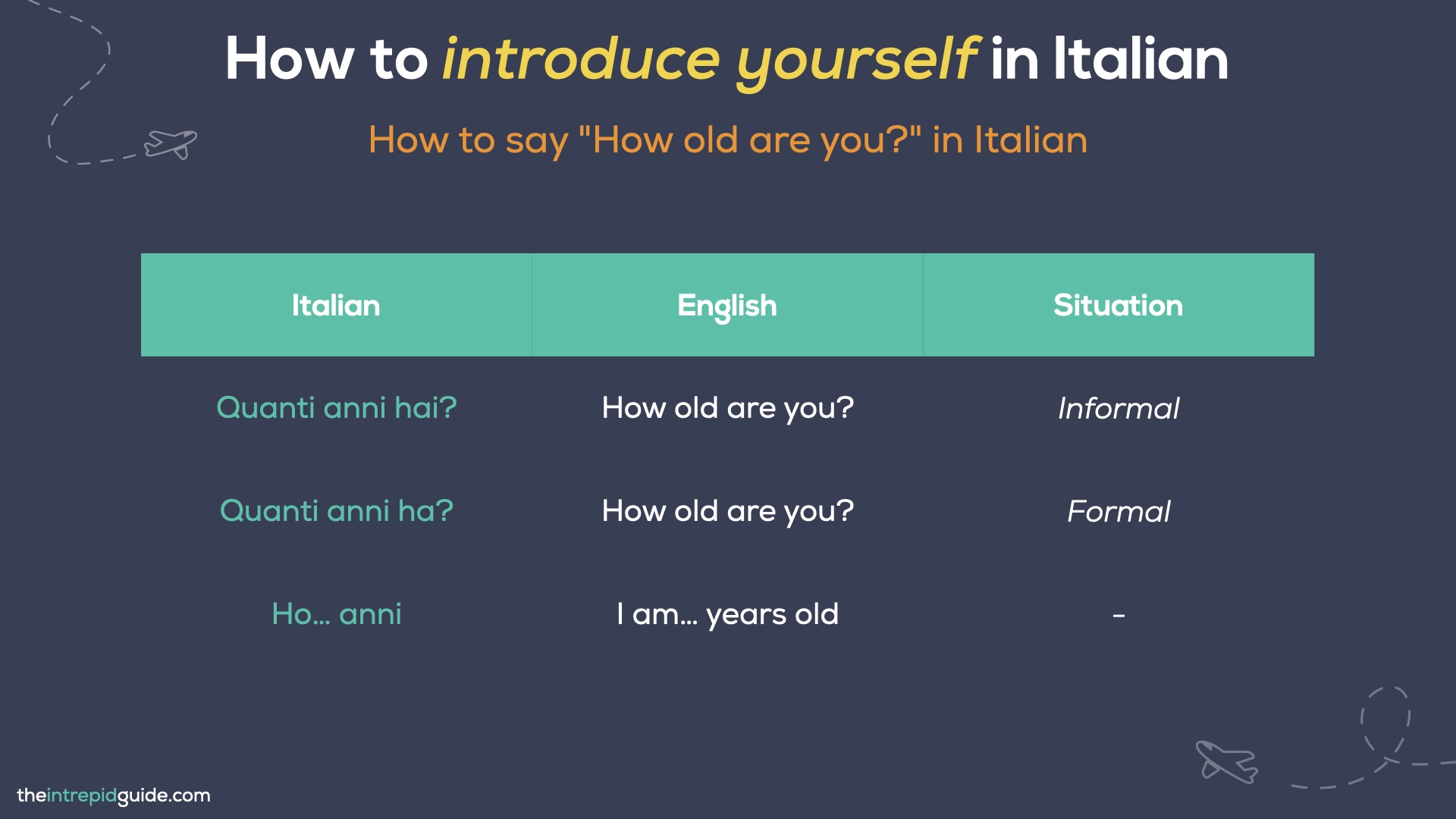
How to ask about relationship status
Imagine chatting with someone you find attractive. Naturally, you might be curious about their relationship status. Like, are they already taken, or perhaps they have kids? While not typically brought up in initial conversations, it’s handy to know how to slide into these topics if you need to.
- Sei sposato/a? – Are you married? (Informal)
- Sei fidanzato/a? – Do you have a boyfriend/girlfrien? (Informal)
- Hai figli? – Do you have kids? (Informal)
- Sì, sono sposato/a – Yes, I’m married
- Sì, sono fidanzato/a – Yes, I have a boyfriend/girlfriend
- No, sono single – No, I’m single
- Sì, ho figli – Yes, I have kids
- No, non ho figli – No, I don’t have kids
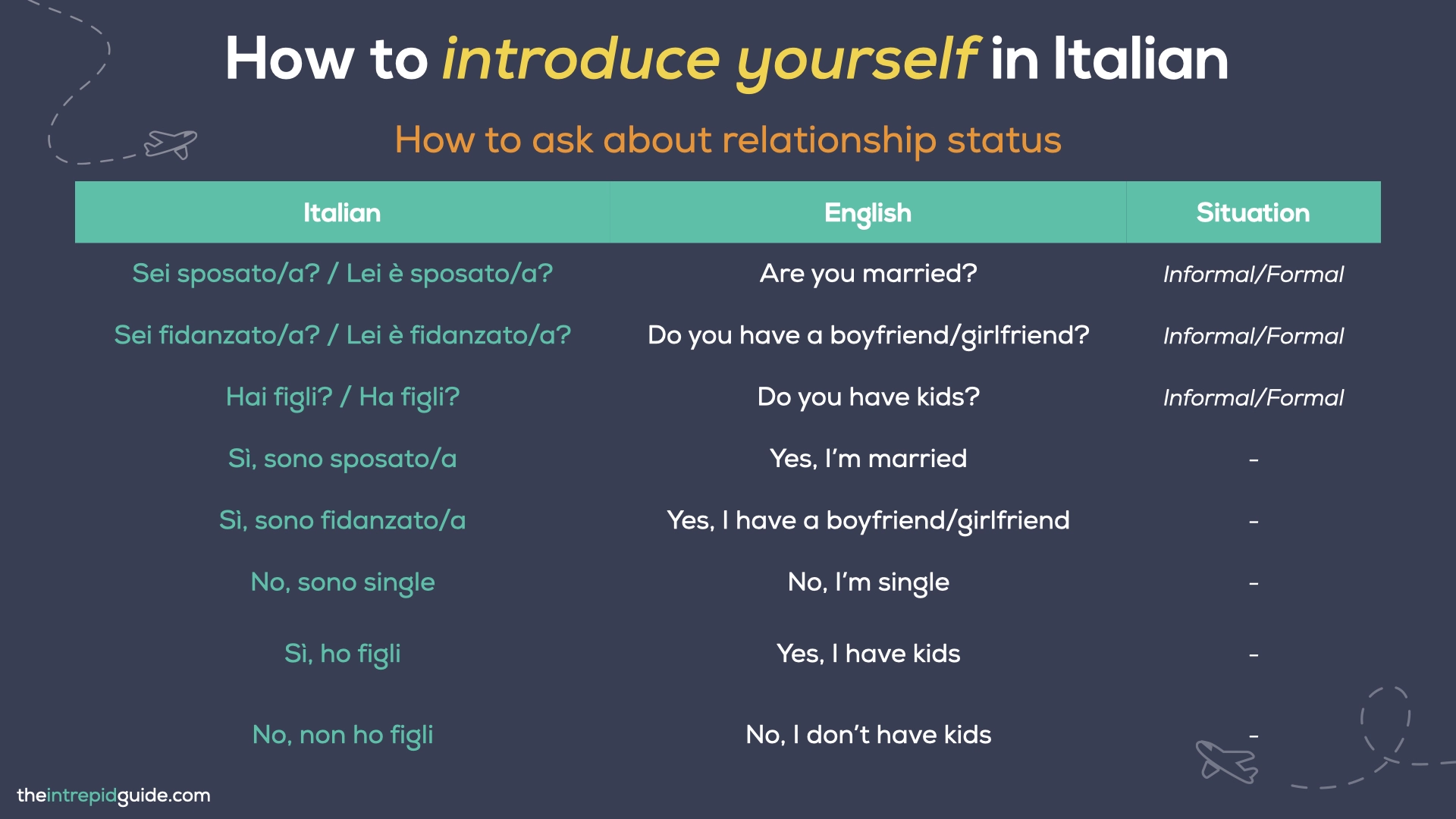
How to say goodbye in Italian
As the conversation draws to a close, it’s time to exchange those parting words. Saying goodbye in Italian encapsulates a spectrum of emotions, mirroring the atmosphere of the interaction. Here are some of the most common expressions:
| Saying goodbye in Italian | |||
|---|---|---|---|
| Italian | English | Situation | Usage |
| Ciao | Bye | Informal | Simple and friendly, suitable for casual farewells. |
| Arrivederci | Goodbye | Formal/Informal | The classic wave goodbye, fitting for any occasion. |
| ArrivederLa | Goodbye | Formal | Adds a touch of class to your departure, perfect for more formal settings. |
| A presto | See you soon | Formal/Informal | Planting a little seed of anticipation for your next encounter. |
| Alla prossima | See you next time | Formal/Informal | Ideal for setting the stage for future rendezvous. |
| È stato un piacere | It’s been a pleasure | Formal/Informal | Sprinkles gratitude into your farewell, adding warmth and sincerity. |
| Ci vediamo | See you | Informal | A casual, breezy way to say goodbye, suitable for friends and acquaintances. |
| Buon proseguimento | Enjoy the rest of the day/event | Formal/Informal | Wishes well for the continuation of something. |
| Restiamo in contatto | Let’s keep in touch | Formal/Informal | Seals the deal for ongoing communication. |
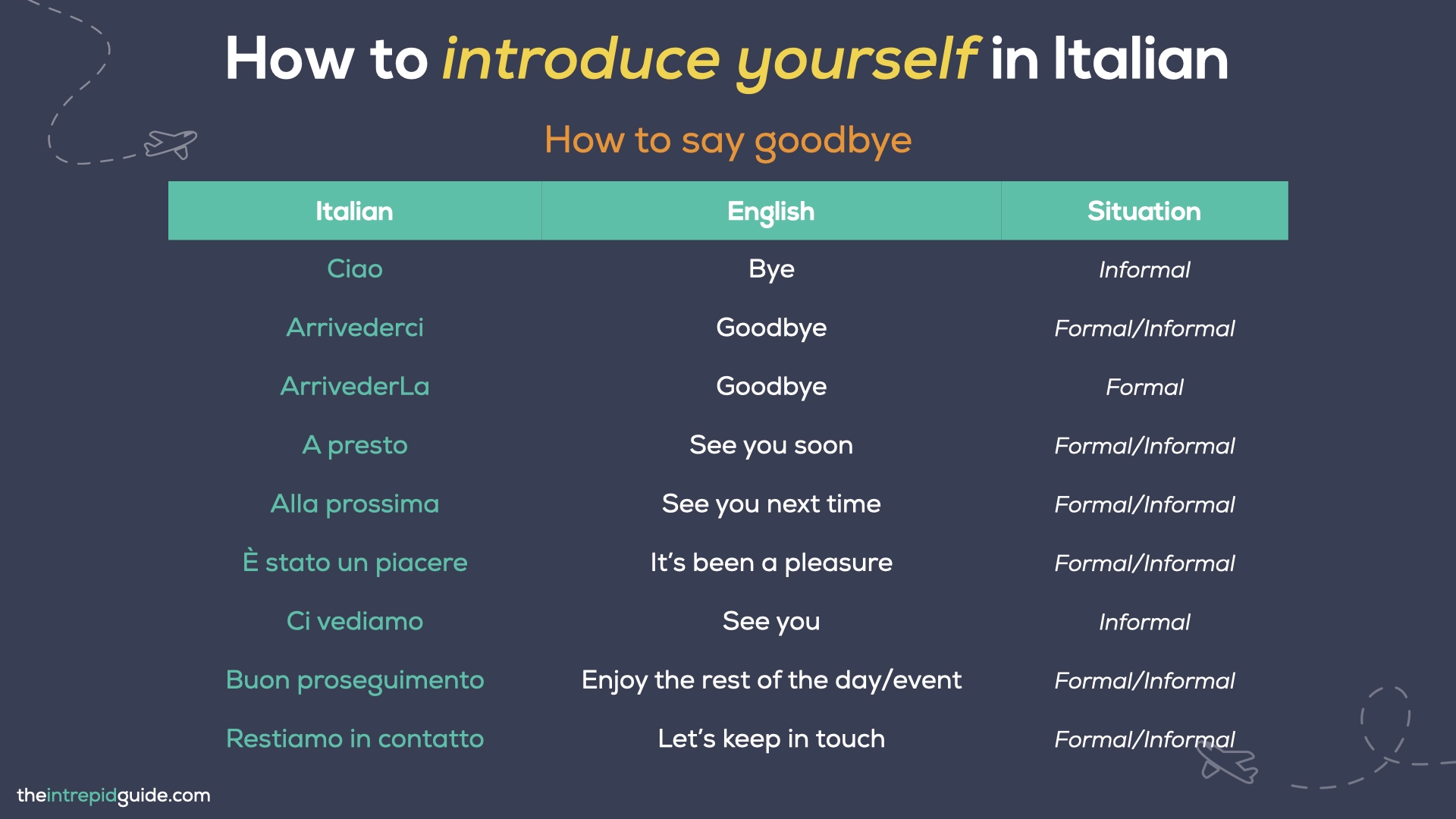
Let’s practice putting it all together!
Now that we’ve seen the main components for introducing yourself in Italian, let’s take a look at a couple of example dialogues that may occur between two people who have just met. Both include basic introductions, questions about where they are from and what they do, and a bit of small talk.
Informal conversation:
A: Ciao! Mi chiamo Kristy. Piacere di conoscerti. (Hello! My name is Kristy. Nice to meet you.)
B: Ciao Kristy, piacere mio. Io sono Marco. Come va? (Hello Kristy, nice to meet you too. I’m Marco. How are you?)
A: Bene, grazie. Anche se questo viaggio è interminabile, non vedo l’ora di arrivare. (Good, thank you. Although, this journey seems endless, I can’t wait to arrive.)
B: Ti capisco… Di dove sei, Kristy? (I hear you… Where are you from, Kristy?)
A: Sono inglese, ma vivo a Milano. E tu? (I’m English, but I live in Milan. And you?)
B: Vengo dalla Puglia ma abito anch’io a Milano! Cosa fai nella vita? (I come from Puglia but I also live in Milan! What do you do for a living?)
A: Lavoro come marketing manager per un’azienda di cosmetici. E tu? (I work as a marketing manager for a cosmetics company. And you?)
B: Sono un architetto. Come ti trovi a Milano? (I’m an architect. How do you find it in Milan?)
A: Mi piace molto. È una città che offre tante opportunità, c’è sempre qualcosa da fare. (I like it a lot. It’s a city that offers many opportunities, there’s always something to do.)
B: Dai, allora potremmo fare qualcosa insieme uno di questi giorni. (Maybe we could do something together one of these days.)
A: Certo, mi piacerebbe! Adesso devo andare, ti lascio il mio numero. (Sure, I would like that! I have to go now, I leave you my number.)
B: Perfetto, allora ti chiamo nei prossimi giorni. È stato un piacere conoscerti, Kristy. A presto! (Perfect, then I’ll call you in the next few days. It was a pleasure to meet you, Kristy. See you soon!)
A: Ci vediamo, ciao Marco! (See you soon, bye Marco!)
Formal conversation:
A: Professor Bianchi, buongiorno. Sono Mario Rossi, primario di chirurgia di questo ospedale. Sono davvero felice di fare la sua conoscenza, ammiro molto il suo lavoro. (Professor Bianchi, good morning. I am Mario Rossi, head of surgery at this hospital. I am truly delighted to meet you, I greatly admire your work.)
B: Piacere mio, dottor Rossi. La ringrazio per la stima. (My pleasure, Dr. Rossi. Thank you for the esteem.)
A: Questo è il mio collega, il dottor Giordano. (This is my colleague, Dr. Giordano.)
C: Lieto di conoscerla, Professor Bianchi, è un vero piacere. (Pleased to meet you, Professor Bianchi, it’s a true pleasure.)
B: Altrettanto. Ma lei non è di qui, vero? Da dove viene? (Likewise. But you’re not from around here, are you? Where are you from?)
C: No, sono piemontese, ma sono anni ormai che vivo qui a Roma. (No, I am from Piedmont, but I have been living here in Rome for years now.)
B: Ah, il Piemonte! Mio padre era originario di lì, per questo mi è sembrato di riconoscere l’accento! Lei di cosa si occupa, dottor Giordano? (Ah, Piedmont! My father was from there, that’s why your accent sounded familiar! What’s your area of expertise, Dr. Giordano?)
C: Sono un chirurgo anch’io. (I am a surgeon too.)
A: Professore ci scusi, ma dobbiamo scappare, ci aspettano in reparto. È stato un piacere. (Professor, forgive us, but we have to run, they’re waiting for us in the ward. It’s been a pleasure.)
C: Arrivederla, Professore. (Goodbye, Professor.)
B: Arrivederci e buon lavoro! (Goodbye and good work!)
5 top tips to remember when introducing yourself in Italian
Sometimes, actions speak louder than words. So, here are some key things to keep in mind for making those initial moments count:
- Smile sincerely: Italians appreciate genuine warmth, so don’t be shy about showing off those beautiful smiles! It really helps create a friendly atmosphere right from the start.
- Master the handshake: when it comes to greetings, a firm handshake is essential. Please avoid limp ones, they just kill the vibe.
- Know when to wave: In more relaxed settings, a friendly hand wave or nod can be enough as a greeting, especially when meeting a group of people at once. It’s a casual yet respectful way to say hi.
- Cheek kisses are for close relationships: While Italians are all about warmth, cheek kisses (or baci sulle guance) are reserved for close friends and family. Kissing someone you’ve just met on the cheek may come off as overly familiar and will definitely raise a few eyebrows!
- The art of kissing hands: the baciamano, or hand-kiss, is a classy move for a gentleman to greet women, but it’s reserved for fancy events and high society gatherings only. So, while you’ll be tempted to channel your inner Mr Darcy with Italian ladies, please save it for the super formal occasions to avoid looking too dramatic.
If you found this lesson powerful, then you’ll love Intrepid Italian, my series of online self-paced video courses that break down everything you need to know about Italian using my 80/20 method. Visit IntrepidItalian.com for more details.
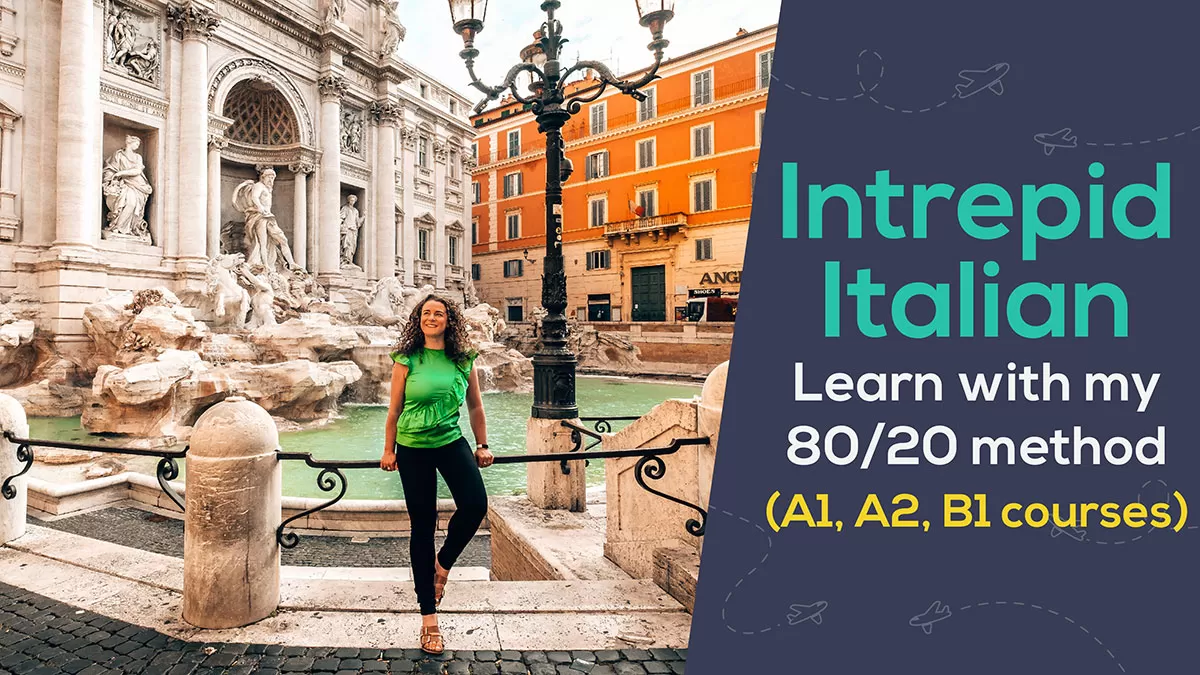 Are you a beginner or an intermediate Italian learner? Got a trip coming up or want to communicate with your Italian partner or relatives in Italian? Learn Italian with my unique 80/20 method
Are you a beginner or an intermediate Italian learner? Got a trip coming up or want to communicate with your Italian partner or relatives in Italian? Learn Italian with my unique 80/20 method
Registrations are now open to join Intrepid Italian, my new series of online video courses that use my unique 80/20 method. You’ll go from a shy, confused beginner to a proficient and confident intermediate speaker, with me as your trusty guide.
You’ll finally be able to connect with your Italian partner, speak to your relatives and enjoy authentic travel experiences in Italy that you’ve always dreamed of, and so much more.
As a native English speaker who learned Italian as an adult, I know what it’s like to feel hopeless and lack the confidence to speak. I know what it’s like to start from scratch and to even go back to absolute basics and learn what a verb is!
Intrepid Italian was created with YOU in mind. I use my working knowledge of the English language to help you get into the ‘Italian mindset’ so you can avoid the common pitfalls and errors English speakers make – because I made them once too! I break everything down in such a way that it ‘clicks’ and just makes sense.
No matter what your level is, there is an Intrepid Italian course for you, including:
- 🇮🇹 Intrepid Italian for Beginners (A1)
- 🇮🇹 Intrepid Italian for Advanced Beginners (A2)
- 🇮🇹 Intrepid Italian for Intermediates (B1)
You can join 1, 2, or all 3 courses, it’s entirely up to you. The best part is that you have lifetime access so you learn anytime, anywhere and on any device.
As your guide, I walk you through each lesson, step-by-step, using my unique 80/20 method. My approach is different from traditional methods because I teach you the most important 20% of the language right from the beginning so you can start to speak straight away.
Each course includes video lessons, audio exercises, downloadable worksheets, bonus guides, a private support community, and lifetime access all designed to streamline your learning while having fun.
It even comes with my famous “Celebrate with a Spritz Guarantee”. After 30 days of using Intrepid Italian, if you don’t want to celebrate your new-found Italian skills with an Aperol Spritz, you don’t have to pay a penny! Cheers! 🥂
Join Intrepid Italian here and start learning today!
Ci vediamo lì! (See you there!)
Learning Italian? Check out these Italian language guides
- Italian for Beginners | How to Learn Italian in 3 Simple Steps
- TOP 100 Most Common Italian Words (Plus PDF Cheat-Sheet & Quiz)
- Italian Prepositions:The Only Guide You’ll Ever Need (PLUS Chart)
- 17 Weird Italian Superstitions Italians ACTUALLY Live By
- 17 Must-Know Italian Hand Gestures: The Ultimate Guide
- 10 Ways Natives REALLY Say ‘You’re Welcome’ in Italian
- How to say ‘Please’ in Italian in 9 Ways Like a Native
- 41 Italian Greetings: How to Say ‘Hello’ in Italian Like a Local
- 125 Most Common Italian Phrases for Travel You’ll Ever Need [PLUS Printable]
- 8 DEADLY mistakes in Italian (& How to Avoid Them)
- How to Conjugate Italian Verbs in 3 Simple Steps [Italian for Beginners]
- Is Italian Hard to Learn? 7 Common Mistakes & How to Avoid Them
- Master Days of the Week in Italian (7 Simple Memory Hacks)
- Italian Numbers: How to Count in Italian From 0 to 1 Billion (Plus PDF Download)
- How to Order Food & Drinks in Italian [Italian for Beginners]
- 15 Italian Words You Should NEVER Mispronounce [& How Not To]
- 11 Effective Hacks That’ll Help You Learn Italian So Much Faster
- Top 14 Italian Words You Should NEVER Say [& What to Use Instead]
- 20 Hilarious Everyday Italian Expressions You Should Use
- Romanesco: 25 Cool Roman Dialect Words You Should Use in Rome
- 10 Reasons Why Learning Italian Will Change Your Life
- 10 Italian Expressions Italians Love Saying
- 10 Italian Phrases That Will Instantly Make You Sound more Italian
- Funny Italian Sayings: 26 Food-Related Insults You Won’t Forget
- 15 Romantic Italian Films That’ll Make You Love Italy Even More
- How to Master Common Italian Phrases for Travel (Like a Local!)
Like it? Pin it for later!

Over to you!
Did you enjoy this lesson? Do you have a question? Let me know using the comments section below or join me on social media @intrepidguide or @intrepiditalian to start a conversation.
Thanks for reading and I hope you enjoyed this post.
Like what you see? Subscribe using the form below to have all of my posts delivered directly to your email.

